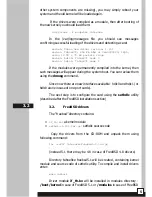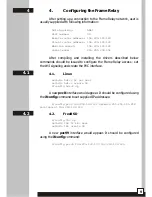
4
option. A list of options will appear, on which you should select
"Generic HDLC layer", appropriate protocols (like "Frame Relay
support") and Tahoe card drivers ("Tahoe 9xx support"). You can
insert them permanently into the kernel ("<*>") or compile as a
module ("<M>").
¡
besides Tahoe drivers you may need to enable other options like
the Ethernet card support, SCSI drivers, multimedia devices, etc.
¡
after configuring a kernel it should compiled:
root@linux /usr/src/linux # make dep
root@linux /usr/src/linux # make clean
root@linux /usr/src/linux # make bzImage
A new kernel should be now installed.
3.1.2.
New Linux kernel installation
After the compilation, the kernel is placed in a file named
/usr/src/linux/arch/i386/boot/bzImage. Now you should copy it to the
/boot directory changing its name to a more meaningful one:
root@linux /usr/src/linux # cp arch/i386/boot/bzImage
/boot/vmlinuz-2.4.24-tahoe
Then you have to install it. The most widely used kernel loader is
LILO (Linux Loader). In its configuration file - /etc/lilo.conf - at the end
you should add new section:
image = /boot/vmlinuz-2.4.24-tahoe
label = Tahoe
root = /dev/hda1
read-only
Instead of /dev/hda1 you may need to enter the name of the
partition where the Linux root filesystem resides.
To install LILO with new settings simply type 'lilo'. Then you can
force loading of a new kernel at the next system boot:
root@linux ~ # lilo
root@linux ~ # lilo -R Tahoe
After entering these commands you should restart your system -
it will boot with the new kernel. If everything works fine, you can add a
line ‘default = Tahoe' to the /etc/lilo.conf file and type 'lilo', so the kernel
labeled 'Tahoe' will be the default one used at the system boot.
If for some reason you cannot use this kernel (e.g. drivers for
5
other system components are missing), you may simply reboot your
system and the old kernel will be loaded again.
If the drivers were compiled as a module, then after booting of
the new kernel you should load them:
root@linux ~ # modprobe tahoe9xx
In the /var/log/messages file you should see messages
confirming successful loading of the drivers and detecting a card:
kernel: Tahoe 9xx driver version: 1.15t
kernel: Tahoe972: 256 KB RAM at 0xd9000000, IRQ5,
using 10 TX + 75 RX packets rings
kernel: hdlc0: Tahoe972 node 0
kernel: hdlc1: Tahoe972 node 1
If the modules were permanently compiled into the kernel, then
such messages will appear during the system boot. You can review them
using the
dmesg
command.
Since now there are new interfaces available - hdlc0 and hdlc1 (or
hdlc0 alone in case of one-port cards).
The next step is to configure the card using the
sethdlc
utility
(described after the FreeBSD installation section)
3.2.
FreeBSD drivers
The “freebsd” directory contains:
if_th.ko
¡
- a kernel module
sethdlc-1.15t.tar.gz
¡
- sethdlc source code
Copy the drivers from the CD-ROM and unpack them using
following command:
tar -zxvlf tahoe9xx-freebsd5.1.tar.gz
(instead 5.1 there may be 4.8 in case of FreeBSD 4.8 drivers)
Directory tahoe9xx-freebsd5.1 will be created, containing kernel
module and source code of sethdlc utility. To compile and install drivers
enter:
make install
Driver module
if_th.ko
will be installed in modules directory -
/boot/kernel
in case of FreeBSD 5.1 or
/modules
in case of FreeBSD
3.2
3.1.2
Summary of Contents for 971
Page 1: ...G 703 PCI Extension Cards TAHOE 971 972 FREEDOM OF COMMUNICATION USER MANUAL ...
Page 2: ......
Page 16: ...12 ...
Page 17: ...13 ...
Page 19: ......




















